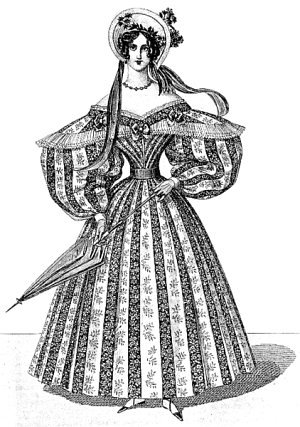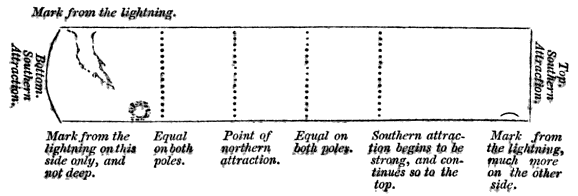
Effects of lightning on Mrs. T.T. Boddington, struck as her post-chariot departed Tenbury on April 13, 1832, as reported in the Lancet:
The … electric fluid … struck the umbrella she had in her hand; it was an old one made of cotton, and had lost the ferule that is usually placed at the end of the stick, so that there was no point to attract the spark. It was literally shivered to pieces, both the springs in the handle forced out, the wires that extended the whalebones broken, and the cotton covering rent into a thousand shreds. From the wires of the umbrella the fluid passed to the wire that was attached to the edge of her bonnet, the cotton thread that was twisted round that wire marking the place of entrance, over the left eye, by its being burnt off from that spot all round the right side, crossing the back of the head and down into the neck above the left shoulder. The hair that came in contact with it was also singed; it here made a hole through the handkerchief that was round the throat, and zigzagged along the skin of the neck to the steel busk of her stays, leaving a painful but not deep wound, and also affecting the hearing of the left ear. … There were marks of burning on the gown and petticoat above the steel; and the inside of the stays, and all the garments under the stays, were pierced by the passage of the fluid to her thighs, where it made wounds on both; but that on the left so deep, and so near the femoral artery, that the astonishment is, that she escaped with life;–even as it was, the hemorrhage was very great.
It also magnetized her corset:

“Both ends attract strongly the south pole of the needle, the upper part for some considerable way down; it then begins to lose power over the south pole, and the point of northern attraction is at about one third of the length of the busk from the bottom; so that by far the greatest portion of the whole has acquired southern attraction.”
